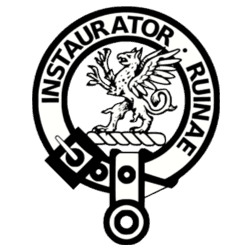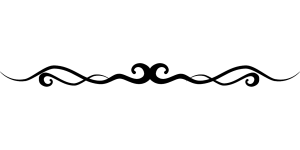‘Armorial bearings do not appertain to all persons of a given surname but belong to and identify members of one particular family. Coats of arms and crests are a form of property and may rightfully be used only by the male-line descendants of the individual to whom they were first granted or confirmed. Such grants were and are made by the appropriate heraldic authority. In Scotland this is the Court of the Lord Lyon.
In Scotland ALL Arms and Crests are PERSONAL. There is NO SUCH THING as a “Family” coat of Arms or Crest or “Clan Crest”. Though the Arms or Crest may be borne by SUCCESSIVE members of a family, they are personal to each in turn. The rules of the inheritance of Arms and Crests are legal and strict.
The Griffin
The griffin, griffon, or gryphon is a legendary creature with the body of a lion and the head, talons and wings of an eagle. As the lion was traditionally considered the king of the beasts and the eagle was the king of the birds, the griffin was thought to be an especially powerful and majestic creature. The griffin was also thought of as king of the creatures. Griffins are known for guarding treasure and priceless possessions. In antiquity it was a symbol of divine power and a guardian of the divine. Gryphon is the original spelling of griffin.
In heraldry, the griffin’s amalgamation of lion and eagle gains in courage and boldness, and it is always drawn to powerful fierce monsters. It is used to denote strength and military courage and leadership. Griffins are portrayed with rear body of a lion, an eagle’s head, with erect ears, and feathered breast, with forelegs of an eagle, including claws. The combination indicates a combination of intelligence and strength.
Very few Scottish families bear the griffin in their heraldic achievement. One is the Forsyths, formerly lords of Torthorwald, who at one time in the early 15th century may have been connected with the Marjoribanks’ in Annandale. Others clans include Bannatyne, Fotheringham, Gladstone, Leslie, and Marjoribanks.
The usage of the griffin by Forsyth’s is that the green/vert griffins were used by the Forsyth/e’s of Nydie, also by the Forsyth/e’s of Tailzerton with the earliest records showing them as being recorded in 1562. Additionally the green griffin was also recorded as the arms assumed by Frederick Gregory Forsaith (3rd Viscount de Fronsac). According to the Scottish Law of Arms, Frederick Gregory Forsaith claiming descendancy from a cadet branch of Forsyth of Tailzerton should have rematriculated and had the proper difference officially assigned to him.

There is also some erroneous belief that the green griffin is used by Forsyth’s originating from Ireland while the blue griffin is used by Forsyth’s originating from Scotland. Obviously this is not correct as both Tailzerton and Nydie are in Scotland. Tailzerton is a “Feu” situated about two miles south of Stirling while Nydie Castle was located in Fife, about three miles west of St. Andrews.
Colour
Colour is an important component of the coat of arms. Each colour used to create a coat of arms has a specific meaning. The following table shows the meaning of each colour on a coat of arms:
|
COLORS |
HERALDIC COLORS |
MEANING |
| Gold | Or | Generosity and high-mindedness |
| Silver or White | Argent | Peace and sincerity |
| Red | Gules | Strength and magnanimity |
| Blue | Azure | Truth and loyalty |
| Green | Vert | Hope and joy |
| Black | Sable | Constancy or grief |
| Purple | Purpure | Royalty, sovereignty and justice |
| Orange | Tenne | Worthy ambition |
| Maroon | Sanguine | Patient and victorious |
Posture
As to the posture, a creature sergeant has both forelegs raised in the air, as a beast rampant, with wings elevated and addorsed (set back to back). This term is reserved to winged quadrupeds (such as griffins and dragons).
The other position is salient. A beast salient (Latin: saliēns, “leaping”) (also springing) is leaping, with both hind legs together on the ground and both forelegs together in the air. This is a very rare position for a lion, but is also used of other heraldic beasts.
Both depictions of the griffin posture used in Forsyth/e arms are correct and it is just a matter of which heraldic charge was chosen by its owner.
However, the use of the green griffins of Tailzerton and Nydie is now historical with those branches of the lineage having died out, and the crowned blue/azure griffin registered as the arms of our chief (Alistair Charles William FORSYTH OF THAT ILK) is the correct crest to be used by all Forsyth’s/Forsythe’s (including those using other spelling variants). For those wanting to know what “of that ilk” means, it means “of that kind” (of the same kind of person or thing as the one just mentioned); having a name that is the same as the place where one lives i.e. Forsyth of that ilk = Forsyth from Forsyth

Chiefs are heads of very large “extended” families, including all of the same surname and probably many “septs” as well. “Septs” are large extended families (i.e. including distant cousins and connections) within a Clan but bearing different surnames from the Clan, usually the result of arbitrary fixing of surnames about the 17th century, prior to which surnames were not general in their modern form in Scotland. When surnames were generally adopted in Scotland in the 17thcentury, some families took the surname of their Chief, not always spelling it in the same way, as spellings were not yet firmly fixed.
The only exception to the use of the Chief’s crest is for other armigers who have recorded their own arms with the Lord Lyon. For example, such as that registered by Bryan Forsyth as his coat of arms.

A person who has registered his or her own coat of Arms and Crest, or inherited these according to the Laws of Arms in Scotland from an ancestor who had recorded them in the Lyon Register, may wear their own Crest as a badge: either on its Wreath, Crest Coronet or Chapeau, or, as is more usual, within a plain circlet inscribed with his Motto. An armiger may also choose to wear instead the Crest badge of his Chief if the armiger is a clansman. An armiger is entitled to one silver eagle’s feather behind the plain circlet, and if he is also a Peer he may add his appropriate coronet of rank on top of the circlet.

Full Arms as recorded for Alistair Charles William FORSYTH OF THAT ILK

Our Chief’s arms also incorporate supporters (the two large griffins either side of the arms), plus baronial robe and chapeau.
Wearing of crest badges
By Clansmen and Clanswomen i.e. the Chief’s relatives, including his own immediate family and even his eldest son, and ALL members of the extended family called the “Clan”, whether bearing the Clan surname or that of one of its septs; in sum, all those who profess allegiance to that Chief and wish to demonstrate their association with the Clan. Wearing a particular clan tartan indicates that the wearer bears an allegiance to the chief of that clan.
It is correct for these to wear their Chief’s Crest encircled with a STRAP AND BUCKLE bearing their Chief’s Motto or Slogan. The strap and buckle is the sign of the clansman, and he demonstrates his membership of his Chief’s Clan by wearing his Chief’s Crest within it.

Although the Crest Badge is purchased by and is therefore owned by the clansman, the heraldic Crest and Motto on it belong to the Chief and NOT to the clansman. They are the Chief’s exclusive heraldic property, which the clansman is only thus permitted to wear.
|
It should also be noted that it is incorrect for Forsyth’s to use a demi-griffin (half a griffin) as that is the crest of the Leslie’s. Their tartan is also similar to ours, having white stripes in place of the yellow stripes used in our tartan. |
Interestingly, we supposedly have an association with the Leslie family, with various confusing claims that either Robert Forsyth III or James Forsyth married Elizabeth Leslie, daughter or grand-daughter of George Leslie the 4th Earl of Roths, along with contradictory dates. Unfortunately my own research has been unable to unearth any supporting documents or publications that confirm and validate these claims. Various publications and peerage records such as those recorded in Burke’s , Douglas’s , and Debrett’s Peerages plus the “Historical Records of the Leslies” do not provide any confirmatory evidence to substantiate these claims.
There is however supported evidence that the 4th Earl did have a daughter (Katherine) to his mistress, Helen Forsyth. On 11 September 1527 Earl George contracted with Sir John Oliphant of Kellie that the latter’s son, Alexander, as yet a pupil, should marry one of the Earl’s lawful daughters by Margaret Orichton. Afterwards, however, the Earl fraudulently married young Oliphant to Katherine Leslie, his illegitimate daughter by Helen Forsyth, a woman of low birth, affirming that she was legitimate. On this and other more personal grounds the marriage was annulled by the Official of St. Andrews on 25 September 1550.
Additionally, on the 1st February 1501, Andrew Forsyth, along with several others, was accused of being art and part with George Leslie, 2nd Earl of Rothes in the charge brought against him of the cruel murder of George Leslie, alias Dunlop. Their bail was forfeited, and they were denounced at the horn, and their goods confiscated.

Article attributed to Clan Forsyth New Zealand – http://clan-forsyth.blogspot.com.au/2012_09_01_archive.html
